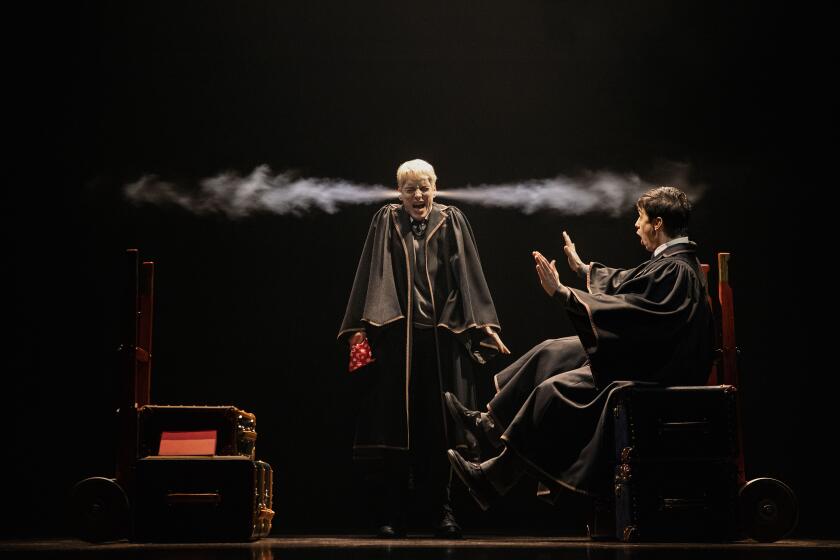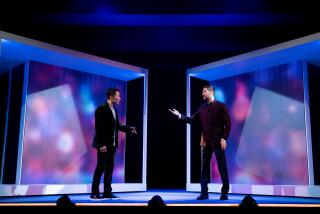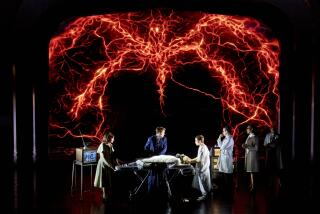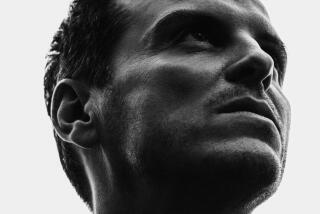‘What does a mega episode of “Stranger Things” look like onstage?’ Inside ‘The First Shadow’
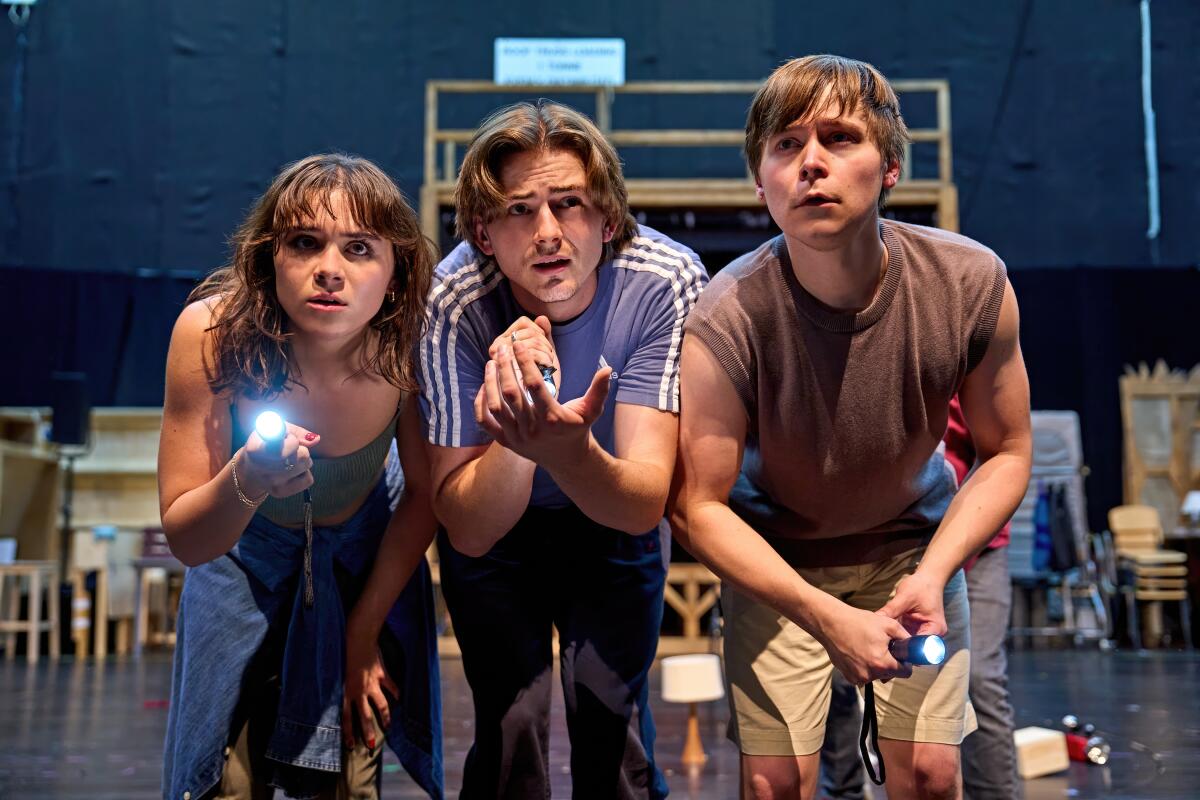
LONDON — Next month, the Upside Down extends its tentacles into London’s West End with “Stranger Things: The First Shadow,” a prequel stage production that expands the world of Netflix’s sci-fi/horror blockbuster.
And the creative team behind it hopes the play will be as groundbreaking as the series itself.
“We’re about to bring the actors, who’ve just been in this cocoon of a rehearsal room for seven weeks, into [the theater],” producer Sonia Friedman says of “The First Shadow,” which is set to open in previews Nov. 17 at the Phoenix Theatre. “We’ve been making sure it can stand alone without the special effects, because it’s all about story. We are going to blow people’s minds. We are going to terrify with some of the most startling, extraordinary things with the physical production.”
The project originated with director Stephen Daldry, who approached Netflix’s then-content chief Cindy Holland after the show’s first season aired.
“One of the conversations Stephen and I had been having was, ‘What theater have we ever seen where you get genuinely scared?’” Daldry’s co-director Justin Martin says. “It was an interesting challenge and provocation. We talked about other [Netflix] titles, but this one felt like the most imaginative and the most challenging to try and find a stage language for.”
“The goal was to figure out, what does a mega episode of ‘Stranger Things’ look like on stage?” adds Matt Duffer, who created the series with brother Ross. “It was a very long, multi-year process to figure that out. But where they’ve landed is incredibly exciting.”
For the Duffers, the idea of expanding the “Stranger Things” universe in new forms was an exciting prospect. They’re currently working on several spinoff shows, including a children’s animated series and an anime series. The play exists on its own, but it also informs the narrative and characters fans know.
“The idea was to explore Henry Creel and his backstory and fill in a gap that we don’t explore in Season 4,” Ross Duffer says of the villain also known as Vecna. “The play was being developed simultaneously with us writing Season 4 so we were adjusting as we went. It was an interesting way to develop a story, but to do it concurrently like that made sure everything locks in mythology-wise.”
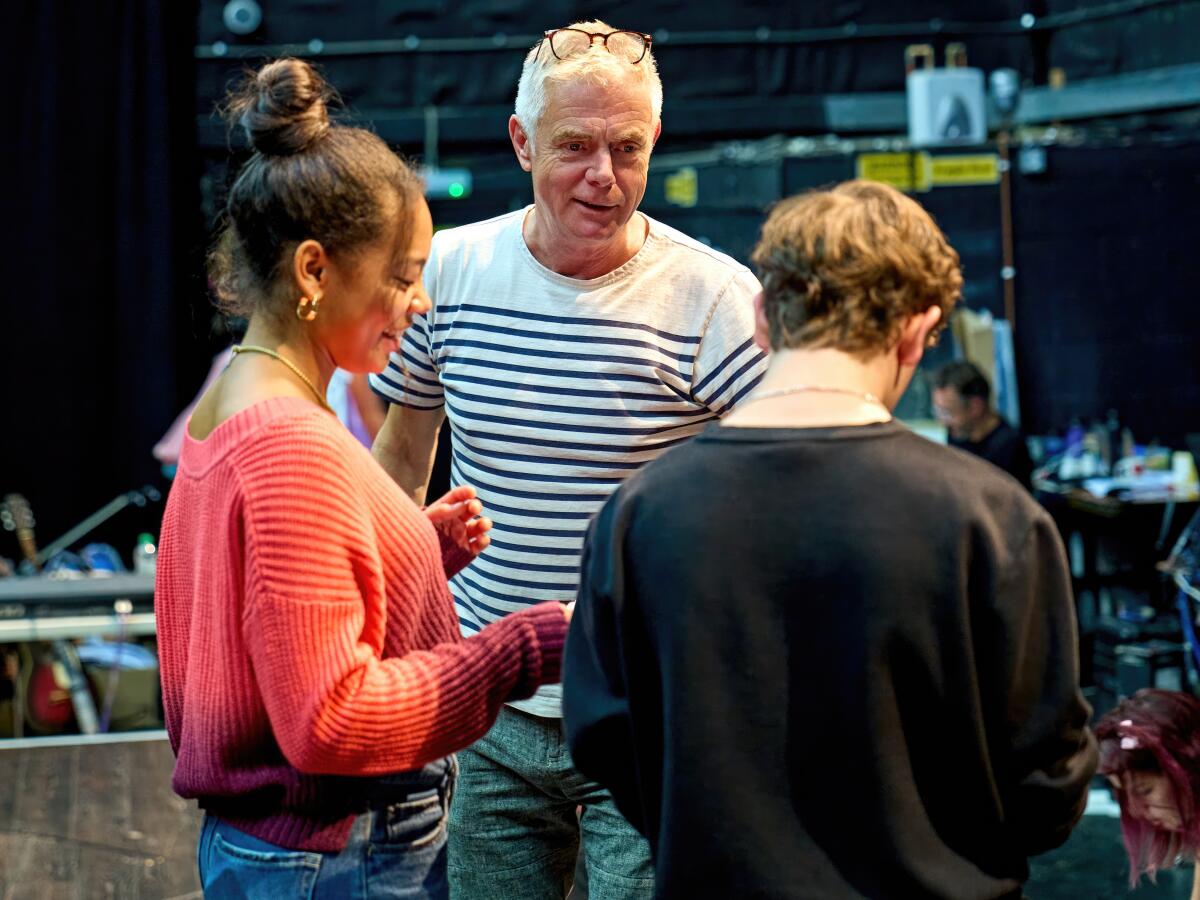
Finding the story
Development on “The First Shadow” began during Season 2. Daldry approached Friedman after seeing the magic and spectacle in her company’s production of “Harry Potter and the Cursed Child” at London’s Palace Theatre. The creative team spent time brainstorming the story during the early months of the pandemic with screenwriter Jack Thorne, but eventually decided they needed someone who knew the series intimately.
Kate Trefry, a writer on “Stranger Things” since Season 2, was an obvious choice for Daldry, despite the fact that she’d never written a play before.
“Season 2 is really when we started to expand this world and mythology,” Ross Duffer says. “So Kate knows that as well as us. She’s been with us in the trenches for so many years that we were so happy that she had this opportunity to do this.”
From early on, no one wanted to simply remake the first season. Daldry wanted the story to be what Martin calls “in the center of the conversation,” rather than a secondary narrative, so a prequel made the most sense.
“When we met with Stephen we had just cracked this Henry Creel stuff in the writers room,” Ross Duffer says. “We said, ‘Well, there might be an opening here.’ And Stephen really fell in love with it.”
“There are questions of ‘Why Hawkins?’ and ‘How did all this stuff happen?’” Martin adds, referring to the show’s fictional Indiana town, which becomes a hotbed of supernatural activity. “This felt like a good way to address that.”
“The First Shadow,” set in Hawkins in 1959, is told over two chapters. Several familiar characters appear, including Bob Newby, Joyce Maldonado and Jim Hopper, who are in their last year of high school when a new student named Henry Creel arrives. Nearby, Dr. Brenner is getting his start in his lab. There are also new characters, like Bob’s sister Patty Newby. Trefry calls it an ensemble play with Henry Creel as the “spine” of the story. Beyond that, everyone involved is as tight-lipped about the plot as they are about the forthcoming grand finale of the Netflix original.
“It’s about outsider kids who come together to solve a mystery,” Martin says. “And in doing so find themselves and each other. That’s really ultimately what ‘Stranger Things’ does so well and why so many people connect with it.”
Trefry adds that it’s also “about the loss of innocence and coming of age and how you are changed and ruined and saved by these formative events that happened in high school.”
“So, hopefully, you’ll see that Hopper and Joyce and Bob are all presenting echoes of the trauma that is at the center of this play,” she says.
In the first season of “Stranger Things,” Joyce, Bob and Hopper seem surprised by what’s going on in Hawkins. But Trefry confirms there’s an explanation for why they don’t immediately connect it to their high school years.
“The climactic events that happen within these two stage episodes had to be something that could be written off as not magical or science fiction,” she says. “It had to be spectacular and make sense, but we had to go forward in honesty with our characters.”
Global theatrical phenomenon ‘Harry Potter and the Cursed Child’ has undergone an overhaul since its 2016 premiere. Here’s why the new version works.
Building the world
As a TV series, “Stranger Things” has a recognizable aesthetic. The Upside Down and its monsters are familiar to viewers, so a stage version needed to incorporate similar visuals.
Because Trefry had never written a play, she didn’t worry about whether certain effects or scenes would be possible, which upped the ante for everyone involved.
“She cross-cut scenes as she would in the show and wrote crazy visual effects sequences as she would in the show,” Matt Duffer says. “She wasn’t limited by that because it then just presented a challenge for Stephen to solve, which is fun. The opening sequence of the play — I don’t think anyone even knew if it was possible. I’m still not sure how they’re doing it.”
Friedman and Daldry put together a notably skilled creative team. Friedman set the bar high from the outset, telling them, “I need to be taken to a new dimension of what is possible with theater.”
That team includes illusions design and visual effects artists Jamie Harrison and Chris Fisher, who are responsible for the onstage magic in “Harry Potter and the Cursed Child.” Harrison and Fisher spent nearly a year coming up with the effects in “The First Shadow” and have continued perfecting things during rehearsals.
“It’s very pressurized because there is nothing worse than a bad effect because the audience knows straight away,” Harrison says. “We have to go through quite a lot of watching our work be quite bumpy before it gets smooth. And we have to bring the actors from zero magic skill to being very expert in a condensed period of time.”
“When you have the world of ‘Stranger Things,’ people know it,” Fisher adds. “They have those big sequences, so we naturally are creating big sequences. We’ve pushed it and I think by us pushing, the directors and Kate have pushed us even more and said, ‘Now we know you can do that, we want this.’”
As a series “Stranger Things” relies on CGI alongside practical effects, but onstage everything has to be done for real. 59 Productions are creating the video design and visual effects for the play, which will work in tandem with the illusions and Miriam Buether’s set design. Harrison says that “anything that can be achieved in film can be achieved in theater.”
“In film, people want absolute reality,” Harrison says. “For the effects to be visually real. In the theater, we have a level of imagination that we can use as well. For example, in the piece we’re creating there are a lot more blood and guts.”
Trefry adds that the stage show is genuinely terrifying. “It’s scary like ‘Stranger Things’ is scary,” she says. “There’s a little bit of like guts and gore, and then there’s also real trauma — people dealing with real stuff.”
Other elements of the production will hint at the series as well. For instance, Harrison and Fisher met with the creature designer from the series during their design process to ensure “visual continuity,” although they won’t say which creatures appear in the play. And D.J. Walde’s original music re-creates the familiar synth theme song with a theremin that matches the late 1950s setting.
For the Duffers, bringing the “Stranger Things” universe to life on stage satisfies their love of practical effects.
“The downside of CGI is that the audience is conditioned to the fact that we can basically do anything,” Matt Duffer says. “But there’s something about seeing it actually done. When I saw ‘Cursed Child,’ my jaw was dropping in a way it rarely does now with these big movies. We want to do the same here.”
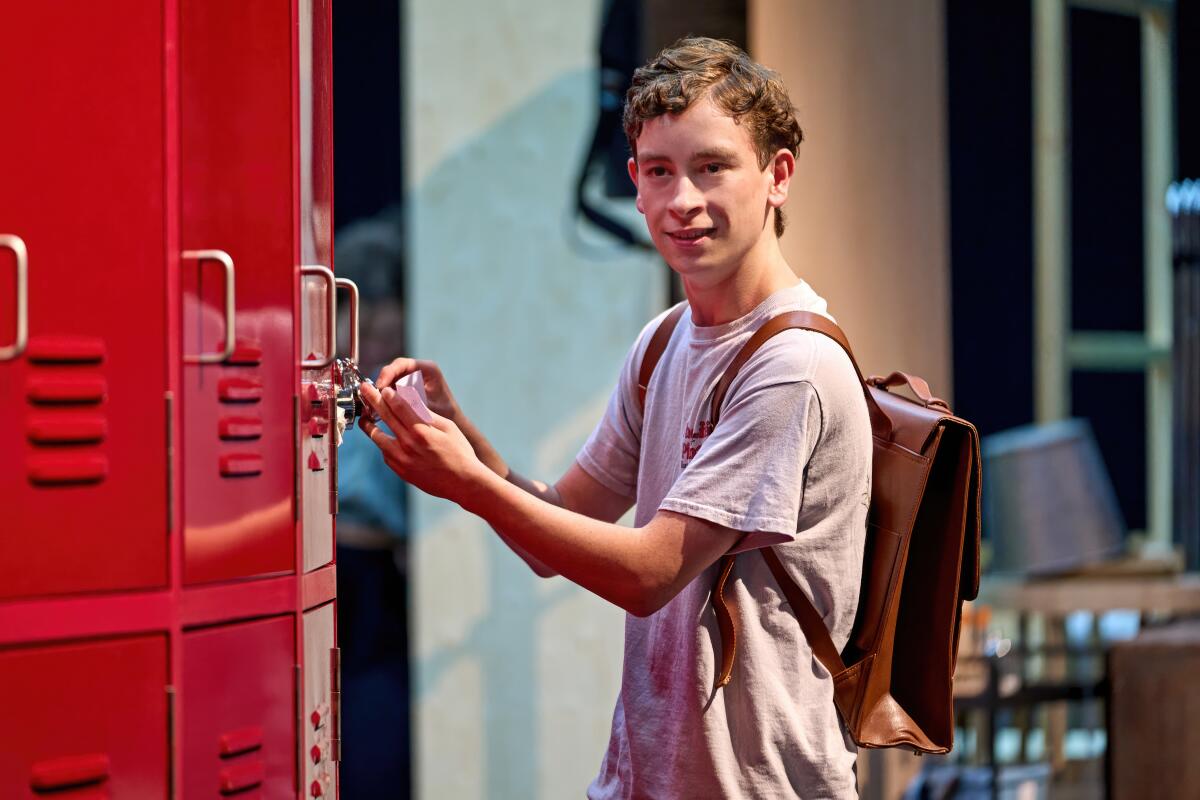
Expanding the universe
Because Trefry wrote the play while Season 4 was in development, the series’ writers were able to retrofit elements of that season to reflect the stage show. The events of the play will also help to “enrich” Season 5, Matt Duffer says.
“There’s a ton of conversation and dialogue between this play and the events that happen in Season 5,” Trefry says of the final season, which is over halfway written. “It was about trying to create something that is canon, but where you don’t have to see it to see Season 5. But if you do see it, it’ll make Season 5 better.”
“There are hints of where [the show] is going to go,” Ross Duffer adds. “I think when [Season] 5 comes together, all of those pieces will hopefully click.”
“The First Shadow” tickets are currently on sale through Aug. 25, 2024, although Friedman confirms the cast signed one-year contracts and the production is open-ended. The plan is to bring the play to Broadway and the rest of the U.S. as soon as possible.
“Hopefully it can get to as many places as it can so as many fans as possible can experience it,” Matt Duffer says. “That’s one thing we’re trying to figure out: How do we make sure people are able to see it before Season 5 releases?”
“The First Shadow” marks the beginning of a broader universe for “Stranger Things.” The Duffers say they can’t “focus on the spinoffs until we’ve landed the plane with Season 5,” but so far they’ve enjoyed letting other artists re-imagine their ideas.
“This was originally pitched as a standalone story and so to be here now is surreal,” Ross Duffer says. “But this has been the most rewarding experience for us creatively.”
More to Read
The biggest entertainment stories
Get our big stories about Hollywood, film, television, music, arts, culture and more right in your inbox as soon as they publish.
You may occasionally receive promotional content from the Los Angeles Times.
